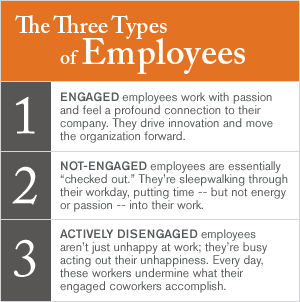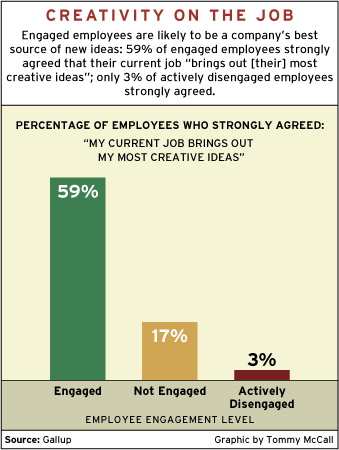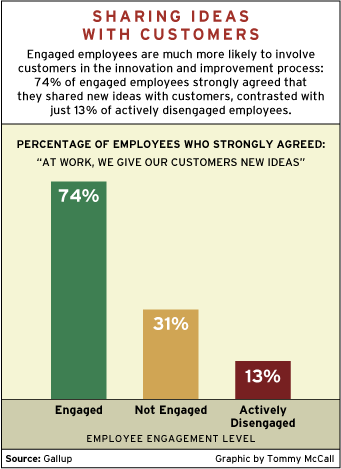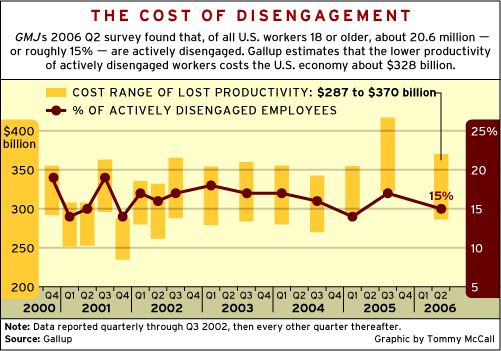The benefits of engagement and strengths
In the 1990s, Gallup concluded a decades-long study into employee engagement. One of the key findings was that employees need 12 essential elements from their workplaces. These elements -- measured by the Q12, Gallup's 12-item assessment of engagement -- reflect a sense of belonging, growth, and contribution. They are also deeply emotional. Though workers do need to be paid -- and though they do like status symbols such as corner offices -- they also need emotional fulfilment. If workers' emotional needs are met, they become engaged with their companies, and their productivity, profitability, retention rate, and safety rate increase
Gallup published its groundbreaking work on strengths. In Gallup's terminology, strength starts with an innate talent -- a tendency to think and behave a certain way -- to seek harmony among group members, for instance, or to enjoy learning for its own sake.
A talent becomes strength when it's refined by skills, knowledge, and practice then consciously applied to something that needs doing -- such as practicing international law.
Engagement starts with managers. To manage toward engagement, leaders must understand the 12 elements and apply them to every worker every day. Strengths, however, are a little different. Strengths develop from innate talents and look different in different people. To develop and work from their strengths, employees must know what their talents are and learn how to hone them into strengths. To make the most out of employee strengths in an organization, managers need to know the strengths of each employee. Then they must create opportunities for employees to use them.
Gallup research has proven that the best way to develop employees -- and net the greatest return on investment -- is to identify the ways in which they most naturally think, feel, and behave, then build upon those talents to create strengths -- the ability to provide consistent, near-perfect performance.Discover What's Right With People, Then Build on It
All organizations seek to improve performance. To get there, though, far too many follow conventional wisdom: Focus on fixing weaknesses. Find what's wrong with your people and try to correct it. Unfortunately, that "wisdom" leaves them struggling on the path to mediocrity.
A growing number of organizations have learned that although weaknesses can't be overlooked -- and must be managed -- fixating on weakness is a mistake.
Gallup Study: Engaged Employees Inspire Company Innovation
National survey finds that passionate workers are most likely to drive organizations forward
When it comes to innovation, business leaders aren't necessarily looking to traditional sources, like research and development departments, to contribute big new ideas. Rather, they're counting on ideas from their employees, customers, and partners to help drive the organization forward. And engaged employees are most likely to contribute those innovations, according to a recent Gallup Management Journal (GMJ) survey of U.S. workers.
GMJ surveyed U.S. employees to discover what effect employee engagement may have on team-level innovation and customer service delivery. Gallup researchers studied employee responses to several items about innovation in the workplace to see which factors differed most strongly among engaged employees (29% of respondents) and those who were not engaged (56%) or actively disengaged (15%). (See graphic "The Three Types of Employees.")
Gallup research has shown that engaged employees are more productive, profitable, safer, create stronger customer relationships, and stay longer with their company than less engaged employees. This latest research indicates that workplace engagement is also a powerful factor in catalyzing "outside-the-box" thinking to improve management and business processes as well as customer service.
When GMJ researchers surveyed U.S. workers, 59% of engaged employees strongly agreed with the statement that their current job "brings out [their] most creative ideas." On the flip side, only 3% of actively disengaged employees strongly agreed that their current job brings out their most creative ideas. (See graphic "Creativity on the Job.")
The study also showed that engaged workers were much more likely to react positively to creative ideas offered by fellow team members.
When asked to rate their level of agreement with the statement "I feed off the creativity of my colleagues," roughly 6 in 10 engaged employees (61%) strongly agreed, while only about 1 in 10 actively disengaged employees (9%) gave the same answer. This suggests that higher levels of employee engagement not only increase the likelihood that individual employees will generate new ideas, it also suggests that idea generation among engaged employees can be amplified when it occurs in a team setting.
GMJ researchers also explored the role that workplace friendships play in promoting innovation. About three-fourths of engaged employees (76%) strongly agreed with the statement "I have a friend at work who I share new ideas with." On the other hand, only 2 in 10 actively disengaged employees (21%) strongly agreed that they have a friend at work with whom they share new ideas. Clearly, friendships do play a significant role among engaged employees when it comes to setting the stage for idea creation and refinement.
The results also suggest that there are significant differences in how engaged and actively disengaged employees view their company's encouragement and acceptance of innovative ideas. Only 4% of actively disengaged employees strongly agreed with the statement "My company encourages new ideas that defy conventional wisdom," while more than half of engaged employees (55%) strongly agreed that their company encouraged such ideas.
Innovation and customer service
GMJ researchers also investigated the effect of employee engagement on customer service innovation. Nearly 9 in 10 engaged employees (89%) strongly agreed that "At work, I know where to go with an idea to improve customer service," contrasted with only 16% of actively disengaged employees.
Engaged employees also involved customers in the innovation and improvement process. When asked to rate their level of agreement with the statement "At work, we give our customers new ideas," 74% of engaged employees strongly agreed that they shared new ideas with customers, contrasted with just 13% of actively disengaged employees. (See graphic "Sharing Ideas With Customers.")
Gallup's employee engagement research has consistently shown a connection between employee engagement and customer engagement. One factor that can influence customer engagement is an employee's willingness to change -- or to "learn and grow" -- to meet the customers' changing needs. When Gallup asked workers to rate the statement "I have grown in my ability to positively affect our customers," the results were telling. Almost 9 in 10 engaged employees (85%) strongly agreed that they have grown in their ability to positively affect their company's customers, while only 2 in 10 actively disengaged employees (19%) strongly agreed.
Finally, more than half of all engaged employees (51%) strongly agreed with the statement "At work, my coworkers always do what is right for our customers."
This was in stark contrast to the actively disengaged employees: Only 1 in 10 strongly agreed that their coworkers always do what is right for their customers.
Gallup's research into the relationship between employee engagement and innovation strongly indicates that engaged employees are far more likely to suggest or develop creative ways to improve management or business processes. They're also far more likely to find creative ways to solve customer problems or to involve their customers in creating service innovations. Company leaders who want to drive growth through innovation should first create an environment that welcomes new ideas -- and should make engaging employees a key component of that strategy.
Results of these surveys are based on nationally representative samples of about 1,000 employed adults aged 18 and older. Interviews were conducted by The Gallup Organization by telephone quarterly from October 2000-October 2002, then semi-annually thereafter. For results based on samples of this size, one can say with 95% confidence that the error attributable to sampling and other random effects could be plus or minus three percentage points. For findings based on subgroups, the sampling error would be greater.
 |
Gallup research has shown that engaged employees are more productive, profitable, safer, create stronger customer relationships, and stay longer with their company than less engaged employees. This latest research indicates that workplace engagement is also a powerful factor in catalyzing "outside-the-box" thinking to improve management and business processes as well as customer service.
When GMJ researchers surveyed U.S. workers, 59% of engaged employees strongly agreed with the statement that their current job "brings out [their] most creative ideas." On the flip side, only 3% of actively disengaged employees strongly agreed that their current job brings out their most creative ideas. (See graphic "Creativity on the Job.")
 |
When asked to rate their level of agreement with the statement "I feed off the creativity of my colleagues," roughly 6 in 10 engaged employees (61%) strongly agreed, while only about 1 in 10 actively disengaged employees (9%) gave the same answer. This suggests that higher levels of employee engagement not only increase the likelihood that individual employees will generate new ideas, it also suggests that idea generation among engaged employees can be amplified when it occurs in a team setting.
GMJ researchers also explored the role that workplace friendships play in promoting innovation. About three-fourths of engaged employees (76%) strongly agreed with the statement "I have a friend at work who I share new ideas with." On the other hand, only 2 in 10 actively disengaged employees (21%) strongly agreed that they have a friend at work with whom they share new ideas. Clearly, friendships do play a significant role among engaged employees when it comes to setting the stage for idea creation and refinement.
The results also suggest that there are significant differences in how engaged and actively disengaged employees view their company's encouragement and acceptance of innovative ideas. Only 4% of actively disengaged employees strongly agreed with the statement "My company encourages new ideas that defy conventional wisdom," while more than half of engaged employees (55%) strongly agreed that their company encouraged such ideas.
Innovation and customer service
GMJ researchers also investigated the effect of employee engagement on customer service innovation. Nearly 9 in 10 engaged employees (89%) strongly agreed that "At work, I know where to go with an idea to improve customer service," contrasted with only 16% of actively disengaged employees.
Engaged employees also involved customers in the innovation and improvement process. When asked to rate their level of agreement with the statement "At work, we give our customers new ideas," 74% of engaged employees strongly agreed that they shared new ideas with customers, contrasted with just 13% of actively disengaged employees. (See graphic "Sharing Ideas With Customers.")
 |
Finally, more than half of all engaged employees (51%) strongly agreed with the statement "At work, my coworkers always do what is right for our customers."
This was in stark contrast to the actively disengaged employees: Only 1 in 10 strongly agreed that their coworkers always do what is right for their customers.
Gallup's research into the relationship between employee engagement and innovation strongly indicates that engaged employees are far more likely to suggest or develop creative ways to improve management or business processes. They're also far more likely to find creative ways to solve customer problems or to involve their customers in creating service innovations. Company leaders who want to drive growth through innovation should first create an environment that welcomes new ideas -- and should make engaging employees a key component of that strategy.
 |
The Q12 items are protected by copyright of Gallup, Inc., 1993-1998. All rights reserved







